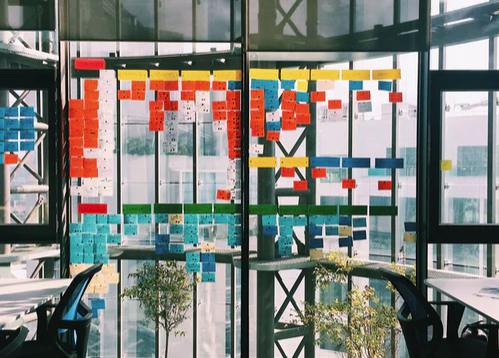Organisational performance is supported by human interactions
Software engineering ultimate measure of performance is driven by the business value delivered. The latest mainly resides in the capacity of an organisation to reach a team performance greater than the one of each individual. Human collaboration is one of the major lever for organisational performance. This collaboration is happening through interactions between a group of individuals, part of a larger team, organisation, and system.

Human interactions between two individuals in the same room are already complex. Distributed and remote teams add significant layers of complexity, thus impacting the communication quality. The natural tendency for each team and individual will be to stay in its silos, comfort zone, for survival. Decisions then tend to be locally optimized, but lacking benefits to the overall organisation. Designing and making happen those interactions is a key driver for remote team performance.
#1 Drive for results, not activities
Managing activities was quite useful for the division of labour applied to physical work, usually based on the Taylorism model. The competition landscape, technology, and culture had already pushed us to evolve towards objective-oriented models. The most known ones being SMART and Management by Objectives (MBO). Based on similar principles, more responsive models emerged with their set of acronyms such as Objectives Key Results (OKRs). Taking a step back, these are models of managing performance through KPIs with least effort.

In our context of a digital organisation, we are oriented towards discovering and scaling successful customer experiences. Achieving fast parallel iterations while scaling profitably requires a supporting and efficient organisation. Specific models formalized patterns for designing the necessary interactions such as SAFe. For instance, a top layer is concerned with the global KPIs and organisational objectives, while other layers on specific KPIs to improve by iterations.
Accelerating and remaining competitive with a KPI-based model is still valid today. In our context, we deploy organisational models to support this acceleration, such as feature-teams. Part of our mission and vision alignment on the preferred lifestyle and family platform, Trust is one of our four core values. We are convinced of its alignment with our purpose to reach our objectives.
#2 Increase ratio of existing interactions with more focus
Distributed and remote teams will – by their nature – lack accidental interactions happening in traditional workplace. Even if unplanned and random, they usually lead to an increase of performance. Our advice in a remote context is to increase the ratio of existing interactions that will increase the probability of accidental interactions.
Pragmatically, we secured to have formal 1to1 with our team and take opportunities to have informal calls on specific topics instead of a chat or an email. We kept our team meetings on a regular basis while testing new ways to handle them. For example, we organised a working session on a topic where people need to participate, collaborate, and engage. Plently of online solutions exists to support remote collaboration.

To successfully increase the existing interactions, balancing productivity and performance, we shorten most of our meetings duration by 50%. It allows better focus on a defined agenda and topics to be worked. Even if remote meetings tend to be more concise, time will tend to use the available space, so keep them as short as possible.
#3 Create a sense of community by increasing new interactions
Having a common purpose and sense of belonging is key for individuals to contribute to something bigger. Creating that community requires regular interactions, common codes, and support between the members.
In a business context where teams are distributed and remote, it means that transversal, new and regular touch points must exist. But the natural tendency for teams is to stay limited to their existing silos and known perimeter. Therefore, defining new and interconnected interactions, with a common purpose and image, will support that global community.
In our context, we designed interactions at various levels of the organisation. At a higher level, regular remote town-hall are organised to keep all teams updated on the business situation. At other levels, we pushed for local initiatives to be implemented. We launched for example weekly informal talks across silos to share on a self-defined topic. It helped for people to discover others and interact while learning. We also clarified the visibility on on-going continuous improvement initiatives led by small teams.

As part of our Definition of Done (DoD), we pushed the peer review to be done with the least known person. Specific communication channels were setup to provide direct support, help and feedback rather than emails. Company clothing and branding materials were already available for the teams. They are useful to create a sense of belonging especially with remote teams. It is an on-going process to keep it alive.
#4 Define the main communication paths and codes
Communication technologies have been exponentially growing, making people contactable through a variety of channels. In contrast, reaching productivity as a group requires the minimum of structured interactions.
There is a balance to find between planned and unplanned interactions. The planned ones can be designed upfront with the supporting processes and tools, such as daily or weekly syncs over a specific communication channel. For the unplanned ones, the focus must be on creating the context for those moments to happen. A concrete example would be to schedule a specific talk in an informal way that would lead people to share on a given subject.

Our practice is to have the simpler setup to limit complexity and scale easier. The meetings are planned and held on Microsoft Teams, where the use of video is recommended. People communicate through channels, tagging the people if they want a specific answer. We recommend to have a Do Not Disturb status during focused tasks or a call. In terms of knowledge management, we favour the use of a document portal for product documentation.
#5 Create a work structure and organise time for performance
Being productive in the digital workplace requires to balance focused time – usually alone – with synchronization time with other individuals. It means that people need to organise their work time and priorities to create this context of performance. Being active or busy is not necessarily linked to getting results. Time is one of the most important resources available for an organisation and must be managed for performance. This is the responsibility of every individual and leader to set themselves for success.
Managing time and results is usually not trained at school nor at work and requires self-management and continuous improvement. Best practices recommend knowing your rhythm by experimentation: morning or evening person, best time for productive work alone, among others. Available materials recommend doing your most important task in the morning starting early with a slot of focused work, followed by most important meetings for medium to long-term results. In the afternoon, check your email twice and keep again some slots of focused versus interactions work. End the day with a retrospective and next day planning.

We tend to have team synchronization reaching the middle of the morning. From 9h15 to 9h30, a global Kanban between all the teams to align the major build and run information. Teams then perform their daily stands-up in 15-30 minutes depending on their context. Morning people tends to have focused work before those moments. Teams then have until lunchtime to perform the most important work.
During the week, we set specific regular moments for mid to long-term progress. We hold Tech Talks on Thursday at 2pm, usually every 2 weeks. Open Talks – that are more informal – take place every Friday at 16h30 for at least 30 minutes. Teams meetings tend to be held on Wednesday or Thursday being a cascade of information or topics from the board. Self-learning time is formally accepted at the end of the workday where each individual adapts to fit his learning type.
A good organisational and interactions design support performance
Taking a step back, the main points we shared are linked to designing organisations and interactions. Limiting to the minimum of interactions required for performance is key to scale the teams, time and resources being scarce. It is a hard balance to achieve between horizontal and vertical animations. Therefore, roles of “Lead” for specific functions can help in supporting different functions within the organisation.

The company culture is a building block required for the design to work. A culture of growth mindset will push people to act out of their comfort zone and siloed decisions. Regular practice enables the creation of simple habits for performance : addressing a conflict with a co-worker, taking your phone to resolve a problem, going to the informal talks to know people, take the slot to present at the next talk, create a routine for your regular meetings or tasks prioritization.
Focusing on an organisational culture that value growth and feedback creates a learning ecosystem where successful interactions drive performance. This is why we are focused on creating a feedback culture and added Curiosity as a company value.
Stay tuned, we aim to share our organisational design evolution in next articles!

